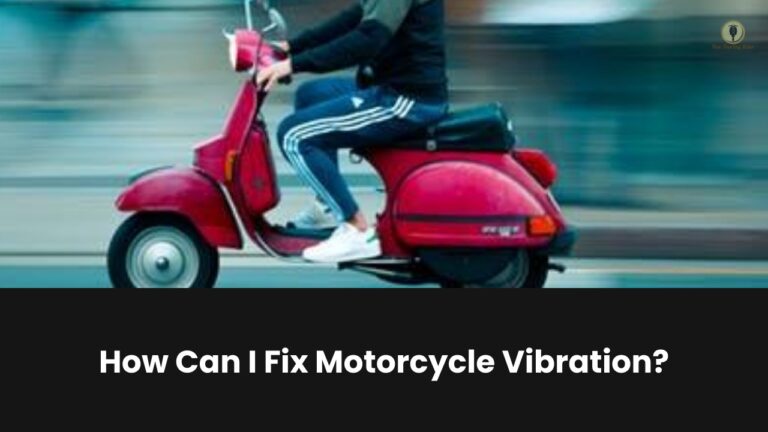If you are a rider, you cannot evade vibration because it’s part of the motorcycle experience. However, too much of it can wear your butt, legs, and hands over time. How can I reduce vibration in my motorcycle? The issue is petty and does not let vibration distract your riding comfort.
What causes motorcycle vibration?
It is simple as you can think of solving a bicycle vibration. Motorcycle vibration is a situation where the gear lever, handlebar, seat, and wheels shake while riding. It is caused by the poor condition of the motorcycle resulting in loose or broken nuts and bolts.
Last week I had the same problem with my favorite motorbike, and I resolved it using the tips explained in this paper. If the problems with your motorcycle exceed, visit the nearby garage for the following checkups:
1. Handlebars and grips
The handlebar is the point of contact between the hand and steering. It is a plastic or rubber handle mounted on the metal bar. We use arms to ride a motorcycle, so the handlebars and grips should be in good condition. If you ride long-distance, your body will develop fatigue and eventually lose control.
Motorcycle handlebar and grip vibration are caused by riding on bumpy and rough roads; since we cannot avoid these poorly constructed roads, we can only ride slowly. As it’s said, prevention is usually better than cure; so, preventing the vibration is better.
2. Seat
Motorbike lovers like motorcycles with a lot of comforts. The seat should provide comfort to the rider at all times. It will be uncomfortable if you ride a motorcycle with a hard seat. A vibrating motorcycle seat is caused by loose nuts under the seat covers and side covers. For those who like riding for long distances and rallies, you can prefer purchasing extra seat covers to satisfy your comfort.
Vibration in the seat will make your buttocks uncomfortable, leading to fatigue at the end of the journey. Since it is every rider’s wish to have an enjoyable ride, expenses on regular maintenance should be incurred.
3. Tires and wheels
No one will like to ride a motorcycle without treads since they cause imbalance when navigating corners. Tires and wheels are rotating parts of the motorcycle and are in direct contact with the ground. The root cause of vibration in wheels is riding the motorcycle with inflated wheels and tires. Keep watching on the wheels’ grips if you use tarmacked roads regularly.
If you cannot realize vibration at the early stages, visit the garage regularly for wheel and tire checkups. Loose wheels are the dangerous cause of accidents when navigating corners and during the rainy season. Keep your tires and wheels inflated and replace them when necessary. When tires and wheels are in good condition, there will be balance hence minimal vibration.
4. Wheel bearings
Wheel bearings are found at the center part of the wheel and make the wheel rotate freely. Broken ball bearings inside them usually cause bearings vibration. How will I know my ball bearings are broken? It’s simple if you’re keen on noticing sounds.
You will hear unfamiliar noises from the bearings and sometimes increased friction. Ball-bearing breakage will lead to accidents. Careful enough, once you hear unfamiliar noise from the wheels when in motion, try to have a checkup in a garage immediately.
5. Chain and belt drive
Chain and belt drive is a belt connecting rear and front wheels. They are connected from each tire/wheel center, and the rear wheel is used as the drive wheel. Chain and belt drive undergoes tear and wear when in motion. When tear and wear occur, vibration between the wheels is heard, and finally, the belt or chain breaks.
Since they are made of durable materials, they undergo friction over time and thus demand replacements. If your motorcycle has a worn-out chain, be sure that overspeeding will cost you due to accidents. To be on the safe side, I regularly inspect my chain because accidents are uncertain. Check the sprockets every time you need to go for a rally or ride.
6. Breaks
It is a joy for every rider to be certain about the good condition of the breaks. Breaks help in reducing riding speed or when you need to stop. Again breaks are important parts of a motorcycle, and they are the joy of riding.
Applying breaks while riding is one of the important cycling measures. Riders who participate in rallies should check their breaks before and after every rally. If you ride your motorcycle responsibly without speeding, you’re lucky. You will not need to go for regular brake maintenance.
Vibration in breaks is caused by loose nuts, missing axels, and worn-out caliper bolts. Loosening or tearing of brake pads might cause accidents when overspeeding.
7. Steering head
The steering head is the rotating end where the motorcycle frame meets the steering. You may fail to notice the breakage in the rotating end unless you come across bumps. Vibration in the rotating end causes swaying on the road and imbalance while riding.
Before riding, move the steering right to left; if there is an unfamiliar feeling, then visit the nearby garage immediately. We cannot negotiate on the tear and wear on the rotating end because metals are prone to friction.
8. Joints
Joints are the meeting ends of all spare parts in a motorcycle. The joints are connected with ball bearings, nuts, springs, and metal plates. When they undergo tear and wear, they become loose, and at long last, they break.
Vibration is the main cause of loosening of joints, and this causes vibration of the whole motorcycle parts. Check regularly the junctions, especially where the engine meets the motorcycle frame.
How to Fix Motorcycle Vibration
The solutions are very simple to be understood by everyone. If you are a keen and attention keeper, you will notice vibrations at early stages and prevent severe side effects on time. I have discussed detailed solutions to motorcycle vibrations.
1. Diagnosis of brand new motorcycles
Brand new motorcycles are usually in good condition. However, manufacturers sometimes cut costs by making incomplete motorcycles or fail to tighten the moving parts. It is advisable to visit a garage for a motorcycle checkup. While in the garage, make sure the motorcycle nuts, bolts, and rubber ends are tightened.
2. Check the manual
Manual is the complete guide of the motorcycle usage and repair if a malfunction occurs. It is a reference guide to usage and maintenance. If you realize abnormal noise and numbness from the motorcycle, it is advisable to use the manual to make the necessary adjustments. If the problem exceeds, visit a garage and provide the manual to the engineer.
3. Use anti-vibration products
Use shock absorbers on handlebars, seats, and foot bars to eliminate vibration. Sometimes you may realize numbness on the arms when speeding. On top of shock absorbers, use recommended gloves to minimize vibration on the handlebars, such as Olympia anti-vibe gloves. On the seats, use cushioned pads to help minimize vibration on the butt. Anti-vibration products are available in all motorcycle shops.
4. Regularly check the brake and disks.
Brake disks become loose with time, and checking them regularly will help. At the time of purchase, ensure they are tight or visit a garage before making any rally. Configure the disks carefully, monitor all joints and rotating parts.
The friction and heating on the crank increases as a result of high mileage! To reduce it, check the oil level regularly and change it whenever it gets old. If you are unaware of how old oil looks like, it is dark and thicker than brand new.
5. Check regularly on wheel chain.
The wheelchair is the driving force of the motorcycle, and it should be monitored over time. The chain bits should be sharp to go round the rear and front cranks; otherwise, they will shift out of the cranks. The chain has limited doubts on brand new motorcycles, although the nuts may be loose, so fasten before going for a ride.
Apply lubricant to minimize the friction on the chain and cranks. You do not need to know about motorcycles for you to identify worn-out chains since there is a big difference between new and worn out. Replace old ones when necessary and use lubricants before going for a ride.
6. Use cushioned/ gel seats.
Long journeys are associated with stiffness and fatigue. Thus, using cushioned seats will help. No one will be happy to experience stiffness while having fun in rallies, so opt for gel or cushion seats for comfort. If you cannot afford to spend pretty cash, go for Wild Ass-Ait Gel pad, and you will enjoy the better part of the ride.
The benefit of Wild Ass-Ait Gel is that it spreads the rider’s weight evenly, thus reducing the pressure exerted on the seat.
The cushion being talked about is different from the one we use for chairs. The ball-like which are inflated with limited air to support the pressure exerted by the rider. The benefit of the inflated cushion is that they do not wear out. If possible, go for the inflated cushions if you want to save some cash.
7. Check every time the steering head.
Since the steering head is the rotating part that meets the steering, it is advisable to have a regular checkup. Regular greasing and oiling the rotating parts near the steering is part of maintenance since friction is unavoidable. Alternatively, you can visit the nearby garage for replacement if the rotating end is worn out.
Shock absorbers can work as well to reduce vibration. However, not all shock absorbers will work for your motorcycle. Some are hard to compress hence adding fatigue and stiffness to the rider.
Conclusion
It is the joy of all motorcycle riders to have comfort and fun on the road. Taking into account all of the above solutions, your journey will be fascinating. However, be sure that not every dealer in the market will sell motorcycles that are well serviced. If you develop pains in the ass, chest, numbness on the hands and legs, visit the nearby garage for diagnosis.
Much is said on motorcycle vibration, but not all vibrations are caused by a malfunction. Others will be a result of the design. Vibration is not a condition to go discussed. Enjoy your ride all time on all roads by servicing your favorite motorcycle.

